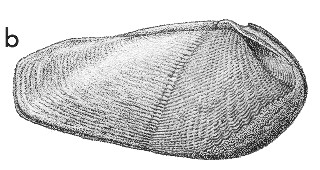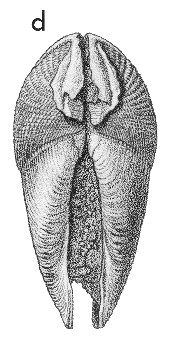
Revised descriptions of New Zealand Cenozoic Mollusca from Beu and Maxwell (1990)

 | Revised descriptions of New Zealand Cenozoic Mollusca from Beu and Maxwell (1990) | 
|
  (Pl. 47b): GS13937, W21/f58, in situ in large boulders in low terrace in front of shelter huts, between Black Reef and Cape Kidnappers, Hawke's Bay, Holocene (2,300 years old; in GNS) |
  (Pl. 47d): GS13937, W21/f58, in situ in large boulders in low terrace in front of shelter huts, between Black Reef and Cape Kidnappers, Hawke's Bay, Holocene (2,300 years old; in GNS) |
Beu & Maxwell (1990): Chapter 16; p. 346; pl. 47 b,d.
Synonymy: Pholas spathulata G. B. Sowerby II 1850 (in 1842-1887), p. 162, not of Deshayes, 1843; Pholadidea suteri Lamy 1926, p. 141 (new name for Pholas spathulata Sowerby, 1850, preoccupied)
Classification: Pholadidae: Martesiinae
Description: Rather small for family (25-50 mm long), narrowly elongate, gradually tapered toward posterior; circular in cross-section (of articulated shell). A single prominent, narrow, diagonal, umbonal-ventral groove present. Anterior end with low umbo, gaping widely for foot protrusion when immature, hemispherical and with ventral gape filled by smooth callum in adult. Posterior end elongate, oval in immature specimens, truncated by base of siphonoplax in adults (siphonoplax chitinous, not found in fossils). Anterior umbonal area protected by thin, fragile, oval accessory plate (mesoplax), preserved in some fossils. Exterior of anterior area sculptured with many moderately widely to very closely spaced, low, narrow, finely crenulate commarginal ridges; posterior area sculptured with low, fine, smooth, widely spaced commarginal ridges. Interior with no hinge teeth, but small, thin apophysis present below umbo (although rarely found in fossils). Pallial sinus very deep; posterior adductor muscle scar narrowly oval, near dorsal margin; anterior adductor scar on dorsally raised shell edge in front of umbo.
Comparison: The less common living Pholadidea tridens (Gray) is stouter than P. suteri, with more prominent sculpture and a calcified siphonoplax. The first fossil specimens of P. tridens were recorded by Beu (2006, p. 300, fig. 38F) from Lower Kai-Iwi Shellbed (oxygen isotope stage 23) at Castlecliff and from Oturi shellbed, Hauriri Terrace cover beds, Waverley Beach, west of Wanganui (oxygen isotope stage 5a), but this is a rare fossil. The Kaawa Creek Opoitian species P. finlayi is similar to P. tridens.
Distribution: Castlecliffian-Recent; Recent, New Zealand (type). The most common rock-boring pholad in the intertidal zone around New Zealand at present, boring in Cenozoic mudstone (and, less commonly, other soft rock) and an important indicator in the fossil record of hiatuses in deposition, as neither this nor Barnea similis survive in any location where sediment accumulates. Not uncommon as a fossil, particularly as loose valves in Haweran near-shore faunules.
Cite this publication as: "A.G. Beu and J.I. Raine (2009). Revised
descriptions of New Zealand Cenozoic Mollusca from Beu and Maxwell (1990). GNS
Science miscellaneous series no. 27."
© GNS Science, 2009
ISBN
978-0-478-19705-1
ISSN 1177-2441
(Included with a PDF facsimile file
copy of New Zealand Geological Survey Paleontological Bulletin 58 in CD version
from: Publications Officer, GNS Science, P.O. Box 30368 Lower Hutt, New
Zealand)